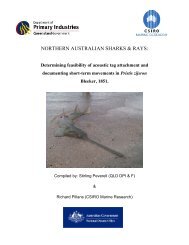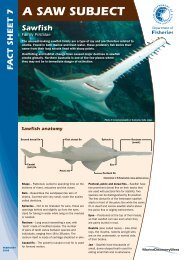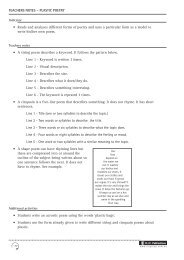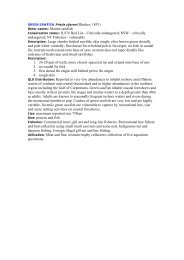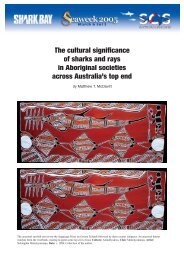September 2005 - Marine Education Society of Australasia
September 2005 - Marine Education Society of Australasia
September 2005 - Marine Education Society of Australasia
You also want an ePaper? Increase the reach of your titles
YUMPU automatically turns print PDFs into web optimized ePapers that Google loves.
aising concerns for the survival <strong>of</strong> the<br />
species.<br />
All marine turtles are experiencing serious<br />
threats to their survival. Based on<br />
information collected along the East coast,<br />
the loggerhead turtle has lost 50-80% <strong>of</strong> its<br />
annual nesting population in the last 10 years.<br />
This information has raised severe concerns<br />
for the survival <strong>of</strong> the species worldwide.<br />
The main threats are pollution and changes<br />
to their habitats, particularly their nesting<br />
sights, sea grass beds, coral reefs and<br />
mangrove forests. Other threats include<br />
accidental drowning in fishing gear, over<br />
harvesting <strong>of</strong> turtles and eggs; and predation<br />
<strong>of</strong> eggs and hatchlings by foxes, feral pigs,<br />
dogs and goannas.<br />
In Australia, all species are protected under<br />
various State and Territory legislation and<br />
the Commonwealth National Parks and<br />
Wildlife Conservation Act 1975. And due to<br />
the increasing threats, five <strong>of</strong> the six<br />
Australian water species are listed under<br />
the Commonwealth’s Endangered Species<br />
Protection Act, 1992. The Loggerhead turtle<br />
is currently listed as Endangered under this<br />
act meaning it may become extinct if the<br />
threats to its survival continue.<br />
The turtle project has become a very<br />
popular display within the Centre and has<br />
proven that education and public awareness<br />
play a significant role in understanding and<br />
appreciation <strong>of</strong> our marine environment for<br />
the local community.<br />
For more information, please contact Phil<br />
Coulthard phoning: (08) 9791 3088 or m<br />
0439 972 632<br />
e-mail: phil@dolphindiscovery.com.au.<br />
Web Page: www.dolphindiscovery.com.au<br />
Unique education programme<br />
inspiring a new generation <strong>of</strong><br />
marine scientists<br />
Pam Elliott, <strong>Marine</strong> Discovery Centre, Woodbridge<br />
In an Australian first, an innovative new<br />
program is providing high school students<br />
from Tasmanian schools the unique<br />
opportunity to work with world-renowned<br />
marine scientists, live marine animals, aboard<br />
a research vessel at the Woodbridge <strong>Marine</strong><br />
Discovery Centre. The successful programme<br />
has already seen graduates entering marine<br />
and environmental science careers.<br />
Set on the shores <strong>of</strong> Tasmania’s<br />
D’Entrecasteaux Channel the WMDC is part<br />
<strong>of</strong> Woodbridge School, owned by the<br />
Department <strong>of</strong> <strong>Education</strong>, and houses fully<br />
equipped teaching areas, an aquarium room,<br />
marine pond, touch tanks and lots <strong>of</strong> displays<br />
as well as the largest collection <strong>of</strong> cool<br />
temperate marine species in Tasmania. It<br />
challenges students <strong>of</strong> all ages to learn<br />
about, discover and care for the marine<br />
environment through diverse shore and seabased<br />
programmes.<br />
A new initiative involving Grade 9/10<br />
students allows students to swap the<br />
classroom for a unique ‘authentic learning’<br />
opportunity spending a week studying live<br />
sharks, seahorses and giant crabs.<br />
Examining sharks around the pond with teacher, Pam<br />
Elliott<br />
Students spend the week working in<br />
research teams out on the water every day<br />
aboard the 13.5m research vessel, Penghana,<br />
contributing to scientific research. They<br />
collect environmental data while studying the<br />
biodiversity <strong>of</strong> four sites in the Channel,<br />
ranging from shallow sheltered bays to 30 m<br />
deep sites with strong current flow.<br />
The students meet and work with marine<br />
scientists from some <strong>of</strong> Australia’s premier<br />
research facilities including CSIRO <strong>Marine</strong> &<br />
Atmospheric Research, the Australian<br />
Antarctic Division, the Tasmanian<br />
Aquaculture and Fisheries Institute and the<br />
14





